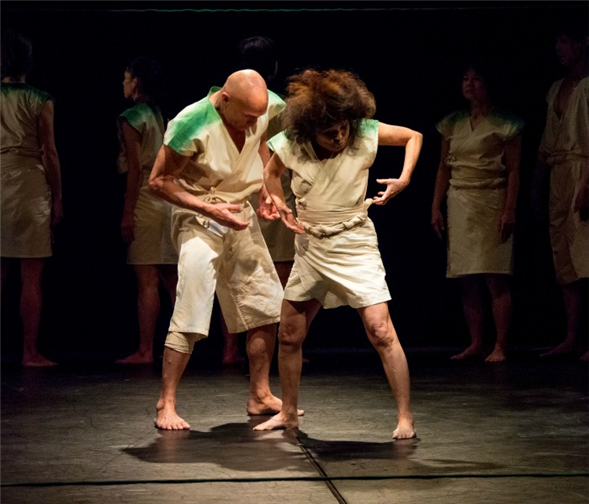Translate Page

Lumberyard's fest features three artists long absent from NYC stages
---
When the leaders of Lumberyard Contemporary Performing Arts were planning their multidisciplinary Winter Festival at New York Live Arts, their first priority was simple. "We wanted to do a season of women," says artistic adviser Dan Hurlin, adding that a second guideline soon emerged. "We started talking about people who haven't been seen in New York in a long time."
That led to booking three mature performer-creators who still have much to say: Japanese dancer-choreographer Kei Takei, African-American theatre-maker Robbie McCauley, and multimedia artist Dana Reitz. Although their performances do not connect in theme or genre, they are all veterans in their respective fields who continue to forge vital work at ages when many others have already retired.
Lumberyard's Winter Festival kicks off this Thursday with two sections of Takei's LIGHT, a multi-part dance diary she began in 1969 as a frustrated Juilliard student. For Hurlin, who was dazzled by Takei's work in the '90s, the opportunity to present her and her Moving Earth Orient Sphere company was personally fulfilling. "I remember when I first saw her, I was completely blown away," he recalls. "It opened my eyes to a way of moving. Then she just went away."
With a little investigating, Lumberyard discovered she had returned to Japan to care for her aging mother. "She had been wanting to come back and it was kismet," Hurlin says. After 17 years away, Takei will once again grace a New York stage, dancing the solo from LIGHT, Part 8 (1974), in which she wraps and twists herself with fabric knots. It's paired with the U.S. premiere of LIGHT, Part 44 (Bamboo Forest), which uses the rare blossoming of a bamboo flower to depict life and death.
From February 1 to 3, Lumberyard shifts to spoken word with McCauley's Sugar, her autobiographical solo show about living with Type 1 diabetes interwoven with the history of the sugar trade. As a longtime professor at Emerson College, from which she retired in 2013, McCauley has been based in Boston for years. Hurlin saw this festival as a chance to bring her back to New York. "In the '80s and '90s, she was revered, and she has continued to be revered because she has been teaching," he says. "She has a massive following of people whose lives she has changed."
McCauley had been writing and developing Sugar for more than ten years before debuting it formally in 2012. "I write in little snippets, journaling and writing down responses to my own feeling and observations," she says, adding that today diabetes is better understood than when she suffered from the disease unknowingly as a child.
In the performance, McCauley says she plays with time in a jazz sense, moving back and forth in different directions, helped by musician Chauncey Moore. "My work is based in a kind of jazz aesthetic that informs the actor's body," she says. "Jazz in the biggest sense of the word: theme and variation."
Her personal story reflects larger issues, such as healthcare and race, but she's careful to keep it engaging. "You don't want to bore people with information -- it's mainly telling my story," she says. "It's also commentary. That's the part where I like to come out of the story and see the audience relate to it."
Lumberyard's festival wraps up February 8 to 10 with Reitz's Latitude, a blend of movement and lighting. Reitz and her fellow dancers perform in silence, using wooden sticks to change the mutable visual landscape.
Reitz has been seen on New York stages more recently than McCauley or Takei, but Hurlin decided to include her since her in-the-moment approach to movement is transformational. "I was a skeptic about improvisation as performance until I saw Dana Reitz," he says.
Though Latitude unfolds without music, Reitz speaks through the movement she creates onstage, as well as the light patterns she designed and directs. Words are in the mix, too, by way of a short poem accompanying the piece in the program:
"three women of varying ages
from far distant homelands
dwell together in a changeable place and with a shifting sense of time
to consider
many aspects of shelter, task, habitat and human connection"
Synthesizing all of Reitz's streams of artistic expression may require active engagement from the audience, but that's exactly the kind of performance Lumberyard likes to showcase. "We aren't looking for crowd-pleasers," says Hurlin. "We are looking for people who are looking for their own line of inquiry."
---
TDF MEMBERS: At press time, discount tickets were available for Lumberyard's Winter Festival. Go here to browse our current offers.
Pia Catton is a writer and editor covering performing arts. She launched Dance.com as its editor-in-chief in 2017, and has written for The Wall Street Journal, Bloomberg, The New York Sun, The New York Post, and others.
Top image: Kei Takei's LIGHT, Part 44 (Bamboo Forest). Photo by Foumio Takashima.